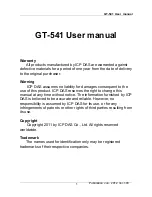
ZyXEL MAX-200M1 Series User’s Guide
219
A
P P E N D I X
B
WiMAX Security
Wireless security is vital to protect your wireless communications. Without it, information
transmitted over the wireless network would be accessible to any networking device within
range.
User Authentication and Data Encryption
The WiMAX (IEEE 802.16) standard employs user authentication and encryption to ensure
secured communication at all times.
User authentication is the process of confirming a user’s identity and level of authorization.
Data encryption is the process of encoding information so that it cannot be read by anyone
who does not know the code.
WiMAX uses PKMv2 (Privacy Key Management version 2) for authentication, and CCMP
(Counter Mode with Cipher Block Chaining Message Authentication Protocol) for data
encryption.
WiMAX supports EAP (Extensible Authentication Protocol, RFC 2486) which allows
additional authentication methods to be deployed with no changes to the base station or the
mobile or subscriber stations.
PKMv2
PKMv2 is a procedure that allows authentication of a mobile or subscriber station and
negotiation of a public key to encrypt traffic between the MS/SS and the base station. PKMv2
uses standard EAP methods such as Transport Layer Security (EAP-TLS) or Tunneled TLS
(EAP-TTLS) for secure communication.
In cryptography, a ‘key’ is a piece of information, typically a string of random numbers and
letters, that can be used to ‘lock’ (encrypt) or ‘unlock’ (decrypt) a message. Public key
encryption uses key pairs, which consist of a public (freely available) key and a private
(secret) key. The public key is used for encryption and the private key is used for decryption.
You can decrypt a message only if you have the private key. Public key certificates (or ‘digital
IDs’) allow users to verify each other’s identity.
Summary of Contents for MAX-200M1 Series
Page 1: ...MAX 200M1 Series IEEE 802 16e Simple Indoor CPE User s Guide Version 3 60 04 2007 Edition 1...
Page 2: ......
Page 26: ...ZyXEL MAX 200M1 Series User s Guide 26 List of Tables...
Page 40: ...ZyXEL MAX 200M1 Series User s Guide 40 Chapter 2 Introducing the Web Configurator...
Page 48: ...ZyXEL MAX 200M1 Series User s Guide 48 Chapter 3 Tutorial...
Page 54: ...ZyXEL MAX 200M1 Series User s Guide 54 Chapter 4 Internet Setup Wizard...
Page 58: ...ZyXEL MAX 200M1 Series User s Guide 58 Chapter 5 VoIP Wizard...
Page 82: ...ZyXEL MAX 200M1 Series User s Guide 82 Chapter 7 WAN Setup...
Page 96: ...ZyXEL MAX 200M1 Series User s Guide 96 Chapter 8 LAN...
Page 130: ...ZyXEL MAX 200M1 Series User s Guide 130 Chapter 11 Phone...
Page 144: ...ZyXEL MAX 200M1 Series User s Guide 144 Chapter 13 Phone Book...
Page 148: ...ZyXEL MAX 200M1 Series User s Guide 148 Chapter 14 Content Filter...
Page 152: ...ZyXEL MAX 200M1 Series User s Guide 152 Chapter 15 Static Route...
Page 162: ...ZyXEL MAX 200M1 Series User s Guide 162 Chapter 16 Remote MGMT...
Page 176: ...ZyXEL MAX 200M1 Series User s Guide 176 Chapter 17 UPnP...
Page 218: ...ZyXEL MAX 200M1 Series User s Guide 218 Appendix A...
Page 245: ...ZyXEL MAX 200M1 Series User s Guide Appendix D 245...
Page 246: ...ZyXEL MAX 200M1 Series User s Guide 246 Appendix D...
Page 248: ...ZyXEL MAX 200M1 Series User s Guide 248 Appendix E...
Page 252: ...ZyXEL MAX 200M1 Series User s Guide 252 Appendix F...
















































